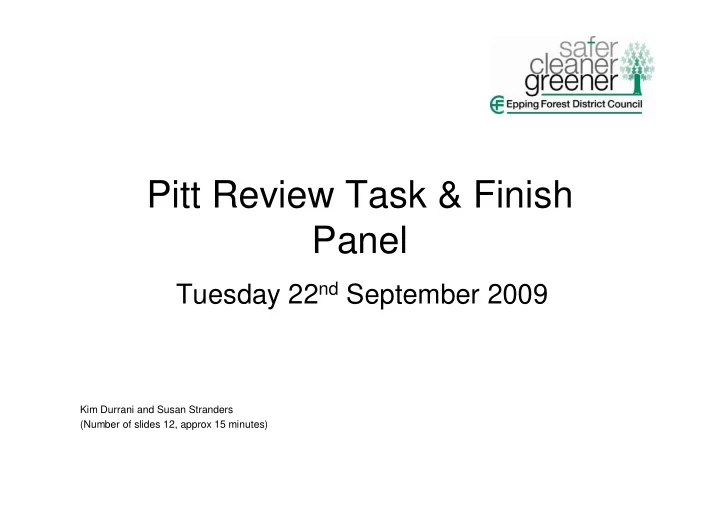

Pitt Review Task & Finish Panel Tuesday 22 nd September 2009 Kim Durrani and Susan Stranders (Number of slides 12, approx 15 minutes)
This is what it is all about
Flood Risk Management - Overview • Focus on fluvial & coastal • EA website shows 1 in 100 &1000 risk • July 2007: 40% fluvial & 60% Surface Water • Pitt Review • Holistic approach to flood risk management • Data: availability, gathering, transfer & modelling • Floods & Water Bill Consultation •National modelling indicates within Epping Forest District there are 1900 properties at ‘significant’ risk of flooding. •EFDC’s own assessment from GIS mapping of historical flooding events estimate: 823 properties at risk from Ordinary Water courses (fluvial) and 1882 properties at risk from rivers and other watercourses (fluvial).
Future Roles and Responsibilities • EA - overview of all flooding • County/Unitary/(Districts etc ?) – local lead for surface water flooding • EA – main river, sea and coastal • County/Unitary Authorities – surface water and ground water • District/Unitary Authorities/Internal Drainage Boards – ordinary water courses
Pitt Recommendations – Local Government Gov steer = ‘implementing Pitt doesn’t need to to wait for the Bill’ • RECOMMENDATION 14:Local authorities should lead on the management of local flood risk • RECOMMENDATION 15: Local authorities should positively tackle local problems of flooding by working with all relevant parties , establishing ownership and legal responsibility. • RECOMMENDATION 16: Local authorities should collate and map the main flood risk management and drainage assets (over and underground), including a record of their ownership and condition. • RECOMMENDATION 17: All relevant organisations (Utilities) should have a duty to share information and cooperate with local authorities and the Environment Agency to facilitate the management of flood risk.
Pitt Recommendations – Local Government Gov steer = ‘implementing Pitt doesn’t need to wait for the Bill’ • RECOMMENDATION 18: Local Surface Water Management Plans to be coordinated by local authorities , should provide the basis for managing all local flood risk (Funding?). • RECOMMENDATION 19: Local authorities should assess and, if appropriate, enhance their technical capabilities to deliver a wide range of responsibilities in relation to local flood risk management (Resources?). • RECOMMENDATION 20: The Government should resolve the issue of which organisations should be responsible for the ownership and maintenance of sustainable drainage systems (Local Agreements?).
Delivery of Recommendations • Surface Water Management Plan (SWMP) ‘ is a framework through which key local partners with responsibility for surface water and drainage in their area work together to understand the causes of surface water flooding and agree the most cost effective way of managing surface water flood risk’. • Ability to share information across organisations. • Council to lead – Tier 1 or Tier 2. • Modelling – extent of?
Delivery of Recommendations • Surface Water Management Plan (SWMP) Holistic view on flooding (fluvial, pluvial, sewerage, highway drainage & ground water). • Sustainable Urban Drainage Systems (SUDs) • Right to connect to sewers will be conditional • LAs to adopt and maintain SUDS • SUDS national standards • National sewer standards
Data collection • Surveys/Asset Register/Geographical Information System (GIS) based. • Obtain data from multiple organisations securely. • Promote & stimulate discussion with all stakeholders.
Pitt Recommendations - Emergency planning • RECOMMENDATION 36: The Environment Agency should make relevant flood visualisation data , available online to Gold and Silver Commands. • RECOMMENDATION 41: Upper tier local authorities should be the lead responders in relation to multi agency planning for severe weather emergencies • RECOMMENDATION 42: Where a Gold Command is established for severe weather events , the police , unless agreed otherwise locally, should convene and lead the multi-agency response . • RECOMMENDATION 68: Council leaders and chief executives should play a prominent role in public reassurance through the local media during a flooding emergency, as part of a coordinated effort overseen by Gold Commanders.
Summary – where we are • Flooding is an issue for EFDC. • We support the Pitt Recommendations. EFDC currently offers an Out of • Hours emergency response to flooding • Some limited Geographical Information System (GIS) data and systems already in place. • Proactively implements PPS 25 (Planning Policy Statement 25 – Development and Flood Risk). • Developing relationships with EA and other professional partners.
What next? • Engage with ECC & EA • Establish with ECC the potential of responsibility that could/would rest with EFDC • Consider extension of Out of Hours emergency response for flooding. • Geographical Information System (GIS) – establish scale of work required. • Joint up working • North East Thames Surface Water Alliance (NETSWA) • Essex Land Drainage Working Partnership
Recommend
More recommend